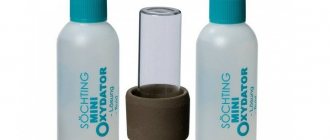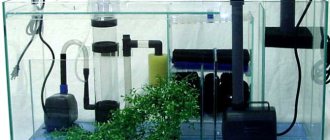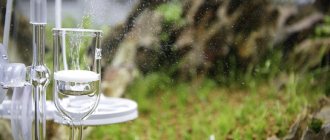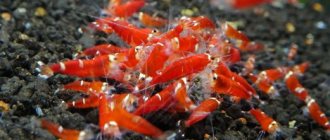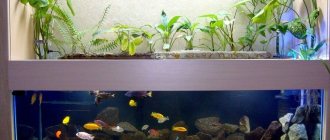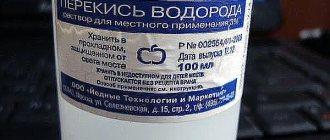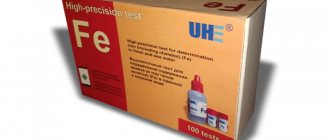Quickly navigate to the article
- 1 Potassium in an aquarium with plants: dosage and use as fertilizer
- 2 Chemistry and life
- 3 Features of different products
- 4 Can you do it yourself?
- 5 Alternative recipe
- 6 Important aspects
- 7 Features of vegetation development
- 8 Features of feeding
- 9 Nuances of application
- 10 About liquid form
- 11 Potassium: about the problems of application
- 12 Sources and features
- 13 Curious aspects
- 14 Chemical reactions and their features 14.1 Other interesting articles
Chemistry and life
To provide your aquatic pets with an adequate and fulfilling life, you need to know how to add potassium to the aquarium and what other ingredients should be present in the water. Plants living in a tiny artificial pond need phosphorus and nitrogen. In addition, sufficient manganese and boron must be provided. Complex fertilizers usually contain molybdenum, zinc and copper compounds. Bicarbonates, calcium and magnesium salts are indispensable.
Ready-made formulations are available for sale. There are many options for liquid fertilizers. They are designed for different flora compositions. You can buy a separate useful substance, or you can buy a ready-made mixture. When determining what exactly a person needs, it is important not only to know what the needs of the farmed aquatic inhabitants are, but also the features of the specific product that appeals to them. Some contain only one substance, others contain multicomponent compounds that are useful for a certain type of vegetation, but can harm other varieties.
Features of different products
When choosing potassium sulfate suitable for an aquarium, as well as considering multicomponent fertilizers with potassium inclusions, it is worth paying attention to the technical features of different products. Some products are sold in ampoules. Their contents are intended for a specific volume of water. How big is indicated on the packaging. There is an alternative form of release - liquid in a large package. The owner measures the required amount from a large container and pours it into the aquarium as needed. It is important to strictly follow the dosage. If the concentration is exceeded, conditions may become unsuitable for the survival of vegetation and fish.
There are fertilizers in solid form. Specialized tablets for aquariums are on sale. They are quite convenient to use, but you need to take into account that each tablet is also designed for a specific volume of water. If the aquarium is larger or smaller than the specified size, the dosage must be adjusted. The instructions accompanying the product must provide detailed information about the rules for using the product.
Can you do it yourself?
Although there are many liquid and solid varieties available on the market, some people prefer to add potassium to their aquarium at home rather than using commercially prepared solutions. The classic recipe for fertilizer for a small glassed-in home pond involves combining water and potassium salt. For 110 g of salt take one liter of liquid. Sulfate or potassium sulfate is used as salt. In order for the chemical components to dissolve well, you need to heat the liquid to a temperature of 25 degrees. If the aquarium is 100 liters, you will need to add 10 ml of the prepared solution.
Alternative recipe
You can make a self-mix of potassium for the aquarium with the inclusion of additional ingredients that are beneficial for vegetation. One of the most popular options involves combining the following ingredients. First, boil 0.7 liters of distilled water, leave to cool slightly, after which magnesium sulfate (10 mg), citric acid (30 g), iron salt (10 g), copper sulfate (0.5 g) and zinc (0.6 g). The solution is infused for an hour, boric acid (one-third of a gram), potassium sulfate (9 g), “Tsitovit” (four copies), “Ferovit” (also four), vitamin B2 (a couple of ampoules) are added. The final step is the introduction of sulfuric acid. Dose – 20 ml. The last component is considered the most dangerous; you must carefully follow the rules for handling the substance.
As all the ingredients are combined, add distilled water so that the total volume is a liter. The drug is fully prepared and can be used to improve the nutritional quality of liquid in a home aquarium. This product should be applied every day. For a 50-liter container, the optimal dose is a milliliter.
Fertilizers for aquarium plants
Aquatic plants are in great need of nutrients of natural origin, but not everyone can afford to purchase them in specialty stores. The reason for this may be the inability to pay for expensive substances or if the owner of the aquarium lives outside the city, which makes shopping difficult. In such cases, the owner of the home pond must independently produce nutritional components.
What's on pet store shelves?
Special substrate additives are designed to nourish the soil and the vegetation living in it. As a result, algae develop well, grow and enrich the aquarium liquid with oxygen, which is actively absorbed by waterfowl. Today, such fertilizing preparations are sold freely or prepared by owners of home ponds according to special recipes.
For a comfortable stay of plants in the aquarium space, you need:
- microelement substances (boron, iron, zinc, copper substances, molybdenum);
- macronutrient components (phosphorus, potassium, nitrogen compounds);
- magnesium, bicarbonate and calcium salts.
Today, on the shelves of specialized supermarkets there is a wide range of complex nutritional products in solid form or in liquid solutions. The most commonly purchased products are AQUAYER Ermolaev iron + (with the iron content required by the aquarium), BIO VERT NANO (a fertilizer containing a complex of feeding elements), Tetra - a dissolving complex on a phosphorus, potassium and nitrogen basis.
Most often, such substances are produced by the manufacturer in ampoules. Before introducing them into the aquarium, you will need to carefully study the instructions for using the drug that fertilizes the aquarium space, because they are designed for a certain amount of water. When purchasing liquid fertilizers, you should also strictly follow the attached instructions, which describe the amount of liquid for a specific aquarium volume.
Solid substances, such as tablets, can be used for aquarium feeding. Before using this drug for the first time, you should carefully read the instructions so as not to harm the pets or vegetation living in the aquarium, however, most often such drugs are prepared by aquarists themselves.
Making your own fertilizers
To make solutions for feeding the aquarium space, you will need minimal knowledge of chemistry and some equipment to carry out the manufacturing procedure:
- Scales accurate to 0.1 milligrams!
- Stirring sticks.
- Beakers.
- Chemical reagents.
- Beaker.
- Rubber gloves.
- Thermometer.
If such scales are not available, you can use others, accurate to the nearest gram. Then you will need to weigh the reactive drugs in tenfold quantities, and use only a tenth of the total weighed contents.
Fertilizer solution manufacturing process
To prepare a solution of a fertilizer preparation based on micro, macroelements and salt compounds you will need:
- zinc and copper reagent;
- potassium permanganate sulfate;
- iron gluconate;
- ammonium milibate;
- boric acid;
- distilled water.
To prepare the fertilizer preparation, you should use a container of at least 1 liter (you can use a jar of this volume).
We pour 0.5 of the liquid after distillation into the jar we are using, and then we need to introduce the reagents in the order determined by the chemists:
- ammonium molybdate – 0.2 g;
- copper sulfate – 0.3 g;
- zinc sulfate – 0.7 g;
- manganese sulfate – 5.4 g;
- boric acid – 17.5 g.
Next, the resulting liquid is thoroughly mixed, and its volume is brought to 1000 g. (1 l.), using distilled water.
How to use fertilizer: This solution must be added per 100 liters. aquarium at least 0.5 ml. The maximum amount of fertilizers for this aquarium volume is 1 ml. This dosage was determined by chemists through complex experiments.
Macronutrient fertilizer
This type of fertilizer preparation is easy to manufacture. You should prepare 3 different solutions of nitrate, potassium, phosphate (it is important not to mix these preparations, but to add them separately inside the aquarium). They should be used daily and in accordance with the dosage.
Making a solution from phosphates
To make a fertilizer preparation you will need 1 liter. a jar of liquid at a warm temperature. Potassium phosphate (72 g) is poured into it, and then the entire contents of the container are thoroughly mixed until the particles are completely dissolved. The fertilizer preparation is used once, and its maximum daily dose is 1 ml. per 100 l. aquarium.
Nitrate fertilizer solution
Potassium nitrate is potassium nitrate. You will need 60 grams of it per 1 liter jar of liquid. This solution is used 1 time, no more than 1 ml. for every 100 l. liquid contained in the aquarium space.
Procedure for making potassium fertilizer solution
Potassium sulfate or potassium sulfate (potassium salt) in a content of 110 grams, is thoroughly dissolved in a liquid at a temperature of + 25℃. This drug requires more for a 100 liter household reservoir - 10 ml.
Cooking method:
After boiling 700 ml. The distilled liquid needs to be allowed to cool slightly. Next, slowly introduce and dissolve:
- Ferrous sulfate – 10 g.
- Magnesium sulfate – 10 g.
- Zinc sulfate – 0.6 g.
- Copper sulfate – 0.5 g.
- Citric acid – 30 gr.
After dissolving the particles of elements, the solution must settle.
Next add:
- 4 cytovits (in ampoules).
- 4 ferovit (in ampoules).
- Boric acid – 0.3 g.
- Ampoule vitamins B 12.
- Potassium sulfate – 9 g.
- Sulfuric acid – 20 ml. When using sulfuric acid, you need to be as careful as possible!
- Add liquid so that there is 1 liter in the jar.
Upon completion of the production of this fertilizer preparation, its use is permitted daily, in a dose of 1 ml per available 50 liters of aquarium liquid.
Where are elements for fertilizing preparations sold?
To purchase these substances, you will need to go to chemical stores, and they exist only in large cities.
Components of simple fertilizers containing macronutrients can be purchased at gardening stores, pharmacies, and other food stores.
According to experienced aquarists, it is better to make these preparations yourself, because when you buy the components, they are much cheaper. Ready-made fertilizers can be stored in a cool and dark place, and its dosage can be changed, judging by the state of lighting, plants, and the aquarium as a whole. However, the preparation of aquarium fertilizers is not an easy process and entails certain consequences, therefore it is recommended to take a responsible approach to the process, dosages and carefully handle the reagents.
Plants in an aquarium come in different types - some take root and receive nutrition through both roots and leaves, others have no roots and, accordingly, feed only through the leaves.
If you plan to plant plants with roots in the aquarium, then take care in advance of the composition of the soil, which should be rich in nutrients and have a pH value from acidic to neutral.
The ideal aquarium is one in which the plants consume macroelements from fish waste, and microelements from tap water added during changes and they have enough of everything and at the same time there is no excess. This is obtained with the correct ratio of the number of fish to the number of plants and the volume of water in the aquarium. And the most important thing is the right light, which will be enough for plants to grow fully. For most plants, the water temperature is +23-+25 degrees. Getting such an ideal aquarium is only possible with practice; no calculations will help here, except very roughly.
If, no matter how hard you try, your aquarium plants look frail and pale, then try using fertilizers for aquarium plants, but not for indoor and garden flowers.
If you are using purchased complex fertilizers, then first introduce an incomplete dose for your volume to see what the reaction will be and whether the algae will be trampled instead of plant growth.
So, what are the types of fertilizers for aquarium plants:
1. Fertilizers applied to the soil to gradually “seep” into the water. Usually in the form of tablets, granules, balls. They will be absorbed by both the roots and leaves of the plant. The downside is that if you have already buried it in the ground and instead of plant growth, massive proliferation of algae has begun, you cannot quickly reduce the concentration of this fertilizer in the water and soil by simply digging it up.
2. Liquid fertilizers applied directly to the aquarium water. They are absorbed through the leaves. The concentration of this fertilizer in water is easily controlled by simple changes.
Most often, poor plant appearance is observed due to a lack of potassium and iron in the water. When they are deficient, the leaves turn white, as the process of photosynthesis slows down.
It is desirable that the water in the aquarium have a pH value of 6.5-7.5 - such acidity is favorable for plants, since most elements at such indicators are in a state accessible to plants, and favorable conditions are created for the absorption of carbon dioxide.
If there are obvious signs of chlorosis, I only add: 1. Iron. I dissolve 0.8 g of vitriol and 1.3 citric acid in 0.33 liters of water. I add 20 ml of solution to a 100 liter aquarium daily. In this way, I maintain the required iron concentration, which is optimal for good plant growth.
This solution can be stored for no more than 2 weeks, so preparing a larger quantity (if only 1 aquarium) does not make sense.
2. Potassium sulfate. I dissolve 80 g of potassium sulfate per 1 liter of water, and add 30 ml per 100 liters during changes.
The remaining nutrients for my plants are sufficient from the remains of the vital activity of fish and fresh, settled water added during weekly changes.
DIY fertilizers for aquarium plants video
Share on social media networks:
Important aspects
The vegetation living in the aquarium requires oxygen. An equally useful ingredient of the environment is carbon dioxide. In order for plants to fully exist and protein generation reactions to proceed normally, nitrogen must be added to the medium. The inhabitants of an aquarium need minerals, without which many vital chemical processes are impossible. As observations have shown, if the owner of an aquarium does not know how to add potassium to the aquarium with his own hands, or what ready-made additives to use, the inhabitants of the aquatic environment begin to need the chemical element. This leads to a slowdown in synthesis. Soon the inhabitants of the reservoir will face a shortage of proteins. Gradually, the color of the leaves will become faded or disappear completely, and the vegetation will begin to lose its leaves.
The relevance of potassium-containing fertilizers for aquariums is that this element disappears from the liquid in which the flora lives especially quickly. The owner’s task is to regularly check the condition, ensure that the chemical balance is maintained, and introduce useful compounds into the environment in a timely manner. To understand what exactly is not enough in the aquarium, you need to take a closer look at the appearance of the plants. If a person does not pay attention to the change in shade and loss of plant parts, and does not add the microelements that the inhabitants of a home pond need, they will simply die.
How to use osmosis
There is no need to enter the element separately. The sodium chloride content in filtered water is minimal, and for plant growth it is enough to add potassium using complex fertilizers MICRO+ and MACRO+. With osmosis, the risk of getting an overdose of a substance is higher than a deficiency. For an aquarium, an excess of an element is dangerous, as is a deficiency - it leads to the death of plants. In an osmosis-filled aquarium, calcium absorption is blocked much more easily than in tap and mixed water.
What are the application rates?
There are no exact norms for adding potassium to water. When the sodium content is not excessively high, the recommended intake for aquarists is 30 mg/l per week. To calculate the dosage for an aquarium, you need to multiply its volume in liters by 30 mg. The resulting amount is the volume of the substance required for plants.
The element can be added in full during weekly water changes or in small portions daily. The method is chosen individually by the aquarium owner. When calculating the weekly dosage, the portion of the substance provided by the fertilizer, which is also added weekly, is also taken into account.
Making your own fertilizer
It is not necessary to buy ready-made fertilizer. Aquarists make self-mix, considering a product made with their own hands to be of better quality. Its advantages are that the content of some components in the composition can be easily reduced, while others can be increased.
Make up a mixture based on potassium and nitrogen. Potassium sulfate (potassium sulfate) in the amount of 38.67% and nitrogen 61.33% are used for its preparation. Substances should be dissolved in different containers so that you can add a pure potassium solution if necessary.
If there are changes in the condition of the plants, the water is tested for mineral elements and their amounts are adjusted.
Watch a video about homemade fertilizers
AdminAuthor of the article
Did you like the article?
Share with your friends:
Features of feeding
You need to know that how to add potassium to an aquarium correctly depends on the characteristics of a particular home pond, as well as its inhabitants. Some owners prefer varieties of greens with powerful roots. If the owner has chosen just such forms, in order to fertilize them, you need to place the fertilizer in the soil area. The easiest way is to use store-bought tablets - there are those that contain only potassium, if they are combined formulations. It is necessary to choose special fertilizers for vegetation living in water. Otherwise, the feeding procedure will be ineffective or even harmful.
Homemade udo (potassium) for an aquarium
Show description Homemade water (potassium) for an aquarium, it is recommended to use from one to four milliliters of solution for every hundred liters of aquarium water daily, it all depends on how many fish you have in the aquarium, the number of plants and the supply of co2, and also depends on what type of water you have light (power, spectrum, etc.). without co2, the rate should be halved or applied every other day. For each aquarium, the amount of application schedule is selected individually. It is important when using homemade or branded aquatic fertilizers that a weekly water change of 25-30% of the volume is required, thank you all, good luck.
Video taken from the channel: Vladimir Rednikov aquarium
Nuances of application
Most of the tablets on sale are universal fertilizer options that can be used to feed almost any aquatic vegetation. In addition to potassium, they contain iron and other ingredients important for the normal functioning of the flora.
Some forms of fertilizer need to be buried in the soil of the aquarium. Only in this way can beneficial ingredients be evenly distributed throughout the environment in which the plants live. The instructions describe at what depth the product should be applied. By following the established rules, the owner guarantees adequate nutrition to the roots of the vegetation.
About liquid form
When choosing how to add potassium to an aquarium, you should take a closer look at the numerous fertilizers in liquid form. Most ready-made store-bought formulations are multicomponent products that contain not only the specified ingredient, but also iron, nitrogen, and phosphorus molecules. Such fertilizers are especially important at the stage of planting seedlings. Liquid products are injected directly into water. They are useful for all vegetation that is not fixed in the ground. Liquid fertilizers are easy to use and it is not difficult to control how much of the ingredients gets into the environment. If by mistake a person added too many substances, you need to drain the water and refill with clean water. It is necessary to apply liquid fertilizers on a regular schedule. This is the only way to adequately control the content of beneficial ingredients in the environment.
Mixed water
Filtration reduces sodium levels in water by three times. The dosage of potassium is also reduced. While maintaining a higher level of a substance than sodium, one must at the same time ensure that this excess is no more than 2-2.5 times; since excess potassium prevents plants from fully absorbing calcium. If there is an imbalance in the content of elements, plant shoots turn white and die within 3-4 weeks. In an aquarium with tap water, an overdose of potassium does not occur, since it always contains a significant amount of sodium.
In mixed water, the level of potassium is maintained by fertilizers, which must be applied at each water change. They compensate for potassium deficiency resulting from its absorption by plants. Additional addition of the element in its pure form may be required once during the initial start-up of the aquarium.
Potassium: about the problems of application
Without proper care, no growth and development of plants can be expected. According to experts in the cultivation of aquatic vegetation, a lack of potassium is perhaps the most common problem for aquarium owners. This trace element is extremely important. In order for the concentration to be stable, the substance must be administered regularly. There are no household devices yet that would allow one to accurately determine in a short time how much potassium is contained in a liquid. This creates the danger of an overdose of potassium in the aquarium, because there are no specialized tests that would show how close the substance content in the medium is to the permissible limit. The only reliable option is to send liquid samples to a laboratory, but this is an expensive method that requires a significant amount of time, so it is not at all suitable for amateurs.
It is important! What to do in such a situation? According to people experienced in keeping aquariums, you just need to constantly add potassium in such an amount as to definitely avoid a deficiency, but not exceed this norm. The characteristics of the cultivated flora are taken into account. Some need more potassium than other species. The standard rate is 5-30 mg per liter for a week. You can add the substance every day, weekly. You can add potassium after a water change, or you can make it a rule to add the substance once every two days.
If it is possible to maintain the potassium content in the liquid in the aquarium at the proper concentration, the vegetation looks attractive and healthy. She grows faster and develops more actively. If signs of potassium deficiency appear in the form of fragility and fragility of plants, loss of parts, the owner begins to introduce potassium and after some time of active growth signs of ill health are observed again, an overdose should be suspected. With such signs, the volume of added substance is reduced.
It is important!
What to do in such a situation? According to people experienced in keeping aquariums, you just need to constantly add potassium in such an amount as to definitely avoid a deficiency, but not exceed this norm. The characteristics of the cultivated flora are taken into account. Some need more potassium than other species. The standard rate is 5-30 mg per liter for a week. You can add the substance every day, weekly. You can add potassium after a water change, or you can make it a rule to add the substance once every two days.
If it is possible to maintain the potassium content in the liquid in the aquarium at the proper concentration, the vegetation looks attractive and healthy. She grows faster and develops more actively. If signs of potassium deficiency appear in the form of fragility and fragility of plants, loss of parts, the owner begins to introduce potassium and after some time of active growth signs of ill health are observed again, an overdose should be suspected. With such signs, the volume of added substance is reduced.
Sources and features
It is not easy to choose the appropriate dosage of potassium for a particular case. Aquariums differ in size, population, and water characteristics. Fish food does not contain potassium, so you should not expect that the water will be replenished with a useful trace element from food. But this compound is present in tap water. True, if the aquarium is densely populated, this amount will be too small. If holes appear on the foliage of aquatic inhabitants, if the edges turn yellow, the leaves become torn, then you need to add potassium to the medium.
There are, however, some nuances. Experts, explaining how much potassium should be normal in an aquarium, point out that on average the concentration of this substance is maintained quite stable. For the normal functioning of vegetation, not much of this compound is needed. But if everything was normal before, but suddenly the plants began to get sick, this indicates that they have lost their ability to absorb the microelement. In this case, there may be a high concentration of potassium molecules in the liquid, but the greens still look bad.
Curious aspects
If parts of plants die, it means that the potassium in the aquarium is not absorbed by the greenery living there. Vegetation elements contain potassium. When they die, they dissolve in the liquid, so the trace element returns to the environment. In fact, this situation looks exactly the same as a lack of potassium. How to understand exactly whether an excess or deficiency of a microelement is the cause of unhealthy vegetation? Of course, the best option is a laboratory test, but it is practically inaccessible to the average person.
It is traditionally believed that adding potassium to an aquarium cannot harm vegetation and does not provoke the development of harmful algae. Some are convinced that this microelement can be safely administered in any volume - there will be no harm from it. Potassium is not as harmless as ordinary people are used to thinking. An excess of this element in the aquatic environment leads to the closure of green growth points and causes leaves to fall off. Such signs are easily confused with symptoms of a lack of phosphorus, nitrogen or other compounds. It must be taken into account that potassium slows down the absorption of calcium, which is already not very abundant in the aquatic environment.
Potassium in the aquarium
Potassium in the aquarium about , but debates about potassium dosages arise from time to time. Some people advise pouring a lot, in addition with regular fertilizers, while others, on the contrary, try to reduce the dose of potassium even in their fertilizer formulations. This article will explain the reason for such contradictions.
To make the article easier to understand, descriptions of biochemical mechanisms will be excluded, and simpler terminology will be used.
For many beginning aquarists, after planting plants in a newly started aquarium with tap water, the first problem is the appearance of small holes on the old leaves of the plants, slow plant growth, and then problems with algae. All these are signs of potassium deficiency and they occur even in cases where fertilizers containing potassium are used.
In osmosis aquariums, on the contrary, additional potassium sometimes causes a deterioration in the appearance of plants. Why?
Let's consider three types of aquariums:
- Aquarium with tap water
- An aquarium with water filtered by reverse osmosis (popularly osmolyat, osmosis) with the addition of tap water to raise hardness to the desired level
- Aquarium using pure osmosis using remineralization with calcium and magnesium salts
Under all equal conditions (fertilizer dosage, presence or absence of CO2 supply, lighting level, number of plants), potassium dosages in these aquariums differ significantly. Why? As you may have noticed, what sets these three types of aquarium apart is the water they use. More specifically, the sodium content in these aquariums. Sodium is a potassium antagonist, meaning it blocks its consumption. Therefore, the higher the sodium concentration in the water, the higher the potassium concentration in it should be to avoid signs of potassium deficiency. However, plants do not necessarily consume potassium in large quantities. It’s just that the concentration of potassium in water must be significantly higher than sodium in order for potassium to become more accessible to plants.
Let's return to our three types of aquariums.
First type
What is the sodium content in these aquariums? The concentration of sodium in tap water in the regions of Ukraine ranges from 5 to 50 mg/l and can reach 100 mg/l or more, and potassium is ten times less. In such aquariums there should be no less potassium than sodium, and preferably more. That is, the potassium concentration can be very high. And adding ordinary fertilizers with potassium, even balanced ones, will not bring the concentration of potassium to acceptable levels in aquarium water soon. Therefore, additional potassium supplementation is necessary. AQUAYER Potassium fertilizer (or AQUAYER AntiToxin+K , which has the same amount of potassium as AQUAYER Potassium) for such aquariums is only necessary at the start. Due to the fact that it is not known what the sodium concentration is in water, potassium has to be added “by eye”. And you need to navigate by plants. As soon as signs of potassium deficiency disappear, additional potassium supplementation should be stopped. In the future, potassium will come with balanced complex fertilizers AQUAYER “Udo Ermolaeva” MICRO+ and MACRO+ , compensating for the drop in potassium concentration due to its consumption by plants.
The diagram does not show fluctuations in concentrations due to water changes.
Second type
In these aquariums, the sodium concentration is 2-3 times less than in aquariums of the first type. Why? Tap water is diluted by osmosis. But in osmosis, the sodium concentration tends to zero (provided that a high-quality membrane is used). Consequently, the potassium concentration in this type of aquarium is needed 2-3 times less. As a rule, this can only be solved by occasional additional addition of AQUAYER Potassium (or AQUAYER AntiToxin+K ) during the start-up period of the aquarium.
Moreover, in aquariums of the second type you already need to be careful with the additional addition of potassium. Because an overdose of potassium can cause difficulty in calcium intake and, as a consequence, the appearance of signs of calcium deficiency (sciatica, whitening of young shoots and their further death). In aquariums of the first type, such an overdose of potassium is unlikely not only because of the higher concentration of sodium, but also because of the higher concentration of calcium (higher hardness) compared to aquariums of the second type.
Third type
They do not need to add any additional potassium at all. As you can already guess, due to the very low concentration of sodium in osmosis. For aquariums of this type, the potassium that is included in the complex fertilizers AQUAYER “Udo Ermolaeva” MICRO+ and MACRO+ . And the risk of blocking calcium intake due to potassium overdose is much higher than in the case of the second type of aquarium.
What is the conclusion? Potassium, like iron, should be on the shelf of most herbal aquarists as a separate fertilizer in addition to complex fertilizers, since potassium dosages differ for different types of aquariums and at different stages of the life of the aquarium. Moreover, as in the case of iron, some plants absorb potassium with particular enthusiasm. For example, Riccia, which is also often used when starting an aquarium as a competitor to algae.
NITRATES IN THE AQUARIUM: DESCRIPTION OF THE REASON, COMBAT, PHOTO, VIDEO.
10 COOL INTERNAL FILTERS FOR AQUARIUM.
NITROGEN CYCLE IN AQUARIUM
INTERNAL FILTER FOR AQUARIUM WITH YOUR OWN HANDS.
Chemical reactions and their features
Potassium is a microelement that has a positive effect on vegetation if present in the environment in adequate concentration. But in case of excessive accumulation, it prevents the greenery from absorbing nitrogen. This makes it impossible for chemical reactions to absorb phosphorus from the aquatic environment. The plant finds itself in a state where there is too much phosphate around to absorb. Moreover, it inhibits the ability to absorb other beneficial substances. The plant ends up in compote and suffers from an overdose. As you can see, all reactions are closely interrelated. To avoid the appearance of such an environment contaminated with various substances, it is necessary to treat feeding responsibly and use potassium in adequate quantities.
Other interesting articles
- What kind of stones can be used in an aquarium with plants Stones for an aquarium: where to find, how to process and use Few people like to watch fish...
- What plants can be added to a 20 liter aquarium? All fish owners want the aquarium to look attractive, their pets to be healthy, it doesn’t take much...
- What plants to plant in an aquarium with angelfish Plants for angelfish Angelfish - these fish of South American origin - love it when the environment...

